[Editor’s Note: We’ve just updated this article with reviewer Paul Forward’s take on the topic, and will be adding other reviewers’ takes soon. You can use the “Article Navigation” bar to jump to each reviewers’ addition.]
Intro
Here at Blister, we spend a good deal of time talking about weight. It’s always a buzzword in the ski industry, with almost every brand bragging about how their new gear as lighter than their old gear. And as a result of all this focus on weight, one of the more valuable things we do is provide an accurate measured weight of nearly everything we review. But, as our editor-in-chief likes to point out, lighter isn’t always better, and plenty of great products (particularly skis) have been dumbed down into too-light, too-weak models.
But when it comes to backcountry skiing, the weight of your gear really matters — it plays a significant role in how far you can go, how long it takes you to do that, and how much fun you have on the way down. That said, there are several areas where you can choose to save weight (e.g., skis, boots, bindings, etc.). So should you be cutting weight in your skis and going with heavier boots? What about choosing an ultralight binding and a burlier ski? Or going with lightweight boots, a heavy binding, and moderately heavy ski? And what about other things in your kit, like packs, poles, skins, and apparel?
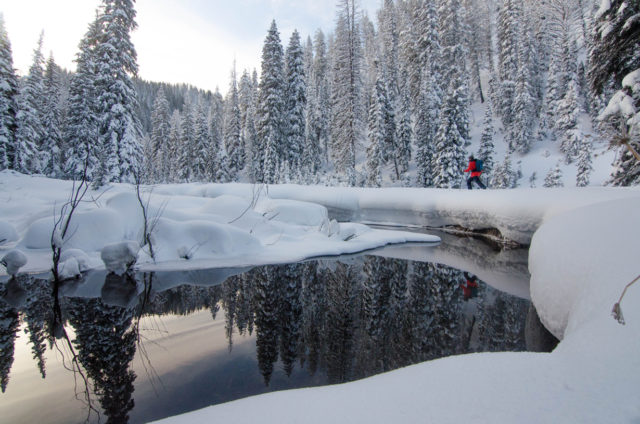
There are a lot of ways to approach this, so here we’re breaking down how several of our reviewers personlly like to look at weight when it comes to ski gear, and how that intersects with the overall performance of their setups. These are our reviewers’ personal takes on the topic, and others’ (including our other reviewers’) opinions differ. So consider this more of a conversation starter, rather than a conclusive statement on the topic, and let us know in the Comments section at the bottom how you think about this.
First: Get Clear on Your Priorities (i.e., “Know Thyself”)
Cy Whitling: In his intro to the first ever Blister Buyer’s Guide, Jonathan Ellsworth emphasized the concept of “Knowing Yourself.” And the more gear advice I give, the more valuable this mantra becomes. If you’re not honest with yourself about your priorities and preferences as a skier, the most expensive gear in the world won’t save you or let you have any more fun, and our reviews will be much less useful to you.
So examine your preferences, think of products you’ve liked, and try to figure out why that was. Then think about gear choices that haven’t meshed with your style, and try to determine why they let you down.
Finally, lay out your objectives as a skier. What do you want the highlights of your ski season to be? Only once you have figured out who you are and what you value can you start to narrow down the ever-growing field of skis, boots, and bindings.
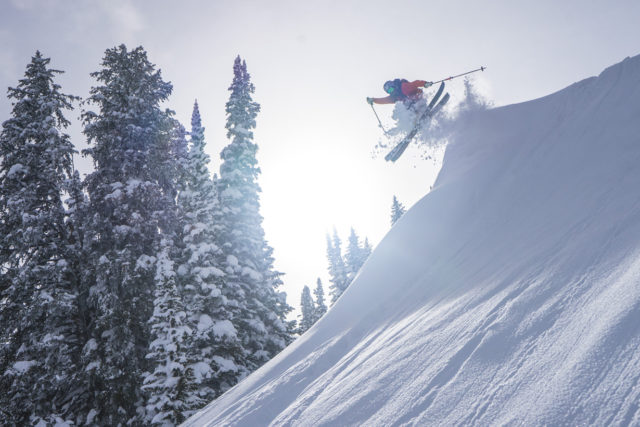
That said, here’s how I personally prioritize weight on my backcountry setups, based on what I want to get out of them and how I ski. I’ve also included a few guiding principles I use when it comes to the weight-to-performance ratio for ski gear.
Cy Whitling’s Take
Skis
Skis generally sacrifice downhill performance as they get lighter, and it’s a fairly linear relationship in most cases. There are a few exceptions, but generally, the lighter your skis are, the less fun you’re going to have in difficult / variable snow, but the more fun you’re going to have on the skin track.
In my experience, a heavier ski often makes a bigger difference in downhill performance than a heavier boot, so I prefer to save weight on my boots and use those weight savings to justify having slightly heavier skis. A great skier can get away with super light skis, but for many of us, those super light skis can get really challenging to ski if the snow is anything less than perfect.
Boots
Boots are a more complicated topic since the lighter AT boots (less than ~1200-1300 g per boot) generally have bigger ranges of motion and often have tech fittings that have been moved closer to the toe to offer a more optimized pivot point. Because of that, by jumping from a ~1500-g boot to, say, an 1100-g boot, you gain a lot of uphill performance. And from my experience with light boots like the Salomon S/Lab X-Alp, I’d say that you lose less downhill performance by dropping ~400 grams in your boots than you would by dropping that same 400 grams of weight in your skis (more on that below). But again, your mileage may vary.
Bindings
Bindings are the most complicated of all, and we won’t dive into all of their intricacies here. Generally though, the heavier you go, the better downhill performance you get, and you often get more reliable release. For example, the fairly heavy Salomon / Atomic Shift offers TUV-certified release and feels like an alpine binding on the way down. On the other hand, very light touring bindings like the Marker Alpinist or Dynafit TLT Speed are not certified for consistent release and feel harsher and less powerful on the downhill.
That said, I’ve personally found that the difference in downhill performance between bindings is much more difficult to determine than it is to determine with boots or skis, particularly when the snow is soft and forgiving.
A Few Examples
This piece was prompted by some experimenting that I’ve been doing as I try to figure out what I want for my big-day ski-mountaineering setup. That presents a specific set of criteria, so if you’re looking to get a touring setup for, say, skiing huge, deep lines in Alaska, your priorities will obviously be quite different (as evidenced by Sam and Luke’s perspectives).
I’ve been skiing back-to-back inbounds and backcountry laps with three different ski and binding setups, and three different boots. Here’s what I’ve been swapping between:
Skis / Bindings
Here are the skis and bindings, with the average weight per ski + average weight per binding:
Salomon MTN Explore 95 / Salomon MTN Binding: 1543 + 324 g = 1869 g total per foot
Atomic Bent Chetler 100 / Fritschi Vipec Evo 12: 1807 g + 515 g = 2322 g total per foot
Atomic Bent Chetler 120 / Atomic Shift MNC 13: 1710 g + 886 g = 2596 g total per foot
Boots
Here are the boots I’ve been playing around with, with the average weight per boot:
Salomon S/Lab X-Alp (size 26.5): 1104 g
Atomic Hawx Ultra XTD 120 (size 26.5): 1576 g
Atomic Hawx Ultra 130 w/ CAST Tech Toes (size 26.5): 1680 g
Some Takeaways from My Testing:
For me, the MTN Explore 95 is the most challenging to ski and the least stable, no matter the conditions or the boot. I skied it in 3 inches of fresh with the Hawx Ultra XTD 120 and felt like I’d forgotten how to ski. The ski felt similar when I was skiing it in the X-Alp.
The MTN Explore 95 is so light that I found myself having to ski it very centered, and make consistent, powerful turns to keep it tracking. When I tried to drive the MTN Explore 95 from a more forward stance I found that the tips were deflecting so much that I constantly felt like I was about to go over the bars. Despite being a very good ski on the downhill for its weight, the MTN Explore 95 was by far the limiting factor in my equation. But, it’s also a dream to tour on.
The Bent Chetler 100 was a blast with either the XTD 120 or the X-Alp, and I don’t notice that much of a difference in performance between those two boots with this ski. Sure, the XTD 120 has a little more ankle support, and is a bit more powerful, but it also fits me a touch better, so I think much of that comes from fit, not the weight difference.
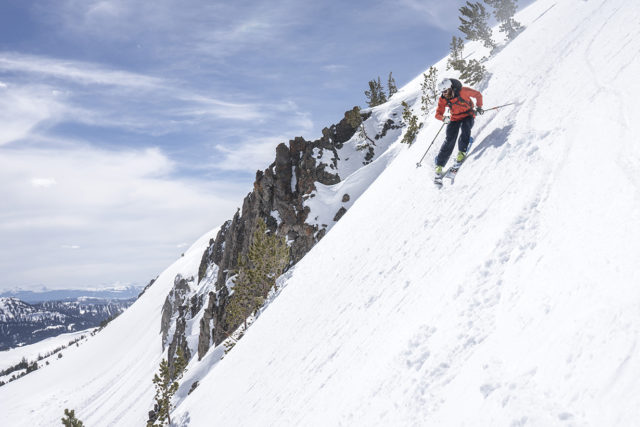
Some of my experience with these boots also might come down to skiing stance / style — I ski with more of a centered stance, so I don’t end up flexing as deep into my boots as some folks do, and lower in the flex is where boots like the X-Alp tend to show their weakness / lack of support. Instead, I’m more aware of lateral stability and the first ~1/3 of a boot’s forward flex. If you tend to drive the front of your skis really hard and flex deep into your boots, there’s a good chance you’ll have a different opinion here.
My most surprising takeaway from this testing was how much fun the Bent Chetler 100 and X-Alp combo was. I skied this combo inbounds on a firm day, and it only took a half a lap for me to feel very confident on it. The S/Lab can push the Bent Chetler 100 hard on edge in chop or on groomers, and the whole setup feels very composed and damp for its weight. I was spinning off cat tracks by my second lap on this combo — not what I expected to be doing in an 1100-g touring boot.
I’ve written a bunch about the Bent Chetler 120 / Shift combo, and I’ve been skiing it a lot with both the Hawx Ultra XTD 120 and the regular Hawx Ultra 130 with CAST tech-toe fittings. I don’t notice that much of a difference between those two boots on this ski. The BC 120 is light enough that, with either boot, I find the limits of the ski before I find the limit of the boot. But the XTD is better on the up, so I’ll continue to stick with that combination when using the BC 120.
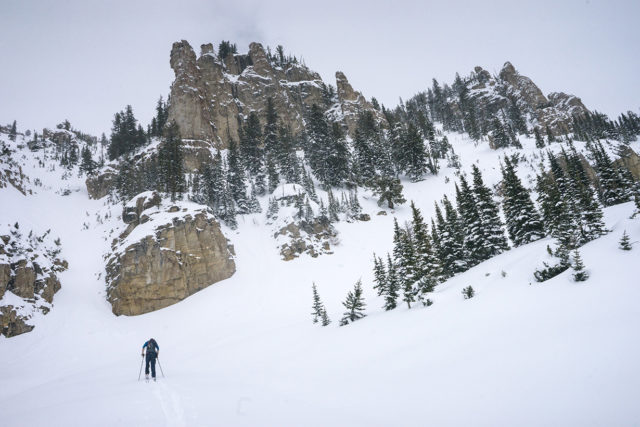
Here’s what those combinations look like based on total weight per foot:
MTN Explore 95 + MTN Binding + Salomon S/Lab X-Alp: 2973 g
MTN Explore 95 + MTN Binding + Atomic Hawx Ultra XTD 120: 3445 g
Atomic Bent Chetler 100 + Fritschi Vipec Evo + Atomic Hawx Ultra XTD 120: 3898 g
Atomic Bent Chetler 100 + Fritschi Vipec Evo + Salomon S/Lab X-Alp: 3426 g
Atomic Bent Chetler 120 + Atomic Shift + Atomic Hawx Ultra XTD 120: 4172 g
My biggest takeaway from those days of testing? Cut weight in your boots, not your skis! I was initially planning on skiing the MTN Explore 95 a bunch this year. Now, I’m not so sure. The Bent Chetler 100 is so much more damp and predictable in all conditions, and it’s much easier to drive. Even with a powerful boot like the XTD 120 that I ski inbounds a fair amount, I found the MTN Explore 95 to be a handful. And even with the S/Lab, which some have dubbed “an ice climbing boot with tech fittings,” the BC 100 still felt like a predictable and powerful ski — even in challenging conditions. When I’m staring into the gut of something consequential, I would personally want to be on the Bent Chetler 100, rather than the MTN Explore 95.
Another thing to consider is that the Bent Chetler 100 tires me out more on the climb than the MTN Explore 95. But I think the MTN Explore 95 takes the same amount of energy out of me, it just waits until the way down, since it requires more input to keep it tracking. I don’t love that.
If I’m trying to figure out the equation of how much energy I have and whether an objective is attainable in a certain time window, I’d rather do the slightly more tiring part first (on the way up). It takes me a lot longer to ski consequential terrain on a lighter setup vs. a heavier one, and I’d prefer to spend a bit more time hauling up a heavier ski in relative safety on a skin track, rather than spend more time in a consequential line because my setup is challenging to ski. That’s how I’ve been thinking about this setup, particularly because it’s what I’d be using for technical lines.
Finally, the difference between the S/Lab X-Alp and the Hawx XTD 120 on the way up was much bigger than the difference between the MTN Explore 95 and the Bent Chetler 100. The X-Alp is not just lighter, it walks a lot better, and is much better when scrambling in technical terrain.
Applications
So, how would I apply this knowledge in practical situations?
My big-day setup this year is going to be the Atomic Bent Chetler 100 with the Fritschi Vipec Evo 12 and the Salomon S/Lab X-Alp. Honestly, I could even use it as a travel setup too, where it would serve some time inbounds. I think it skis as well as it goes uphill, and it goes uphill very well.
More broadly: Don’t be afraid to put tech bindings on heavier, inbounds-oriented skis. It’s a blast. Over the last few years, I’ve put tech bindings on the Revision Subtraction, K2 Shreditor 112, Sego Big Horn 106, and now, the Atomic Bent Chetler 100. Each one of these setups has skied much better than any lighter, touring-specific ski I’ve ever been on, and does so at a palatable weight penalty for me. It’s no surprise that some of our favorite touring skis (e.g., 4FRNT Raven) are also pretty heavy compared to other touring skis. Don’t be scared by a heavier touring ski — chances are, you’ll feel more confident when it comes time to rip skins.
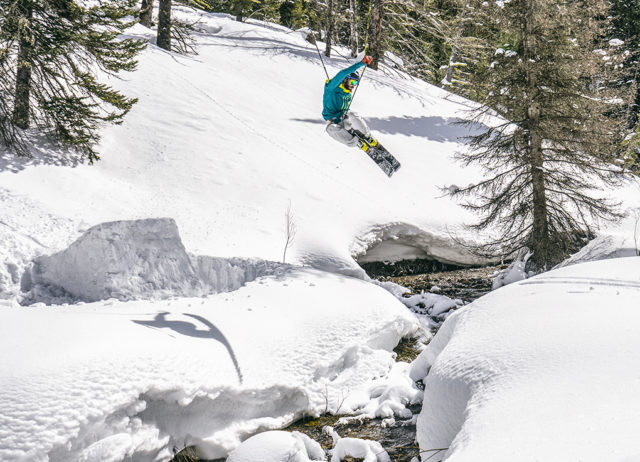
And to be clear, I’m not telling you to put tech bindings on your dedicated alpine setup — if you’re not using a ski to walk uphill a lot, you’d be better off on a burlier binding like the Shift. But for touring, having a heavier ski with lighter bindings (and boots) can be a ton of fun.
But you don’t need to go full hog and get the heaviest everything. Bindings like the Dynafit Rotation 10 and Fritschi Vipec Evo ski really well, and they’re plenty powerful to drive a heavier, inbounds-oriented ski. As a result, I don’t personally feel the need to jump up to a frame binding or Shift for performance reasons, but rather for safety and durability reasons.
And I’ve also found that I personally don’t need the gnarliest, burliest touring boot out there. In my experience, a slightly heavier ski with a slightly lighter boot rewards me a lot more on the downhill than a lighter ski and a heavier boot. So consider giving your ankles a break and checking out a lighter boot with a higher range of motion. You’ll notice it on the up, and you might be surprised by how little you notice it on the down, particularly if you don’t tend to drive your skis super hard.
Finally, and this is a little hypocritical, but don’t get too caught up in the weight weenie game. You don’t need to cut the handle off your toothbrush. Skiing is fun, whether you’re doing it on a 2100-g ski or a 1200-g ski. Don’t let a preoccupation with the weight of your gear take away from your experience.
Sam Shaheen’s Take
Last winter, Cy Whitling offered his take on the best ways to save weight in a ski-touring setup, and it’s time now to add my own two cents. We’ll also be adding other reviewers’ takes soon.
If you are regular listeners to our GEAR:30 podcast you know that our reviewers sometimes have different takes on a variety of topics. Because of this, we like to discuss and expand on any topics that are controversial within Blister, hence our expansion of this idea of where to save weight in your backcountry ski setup.
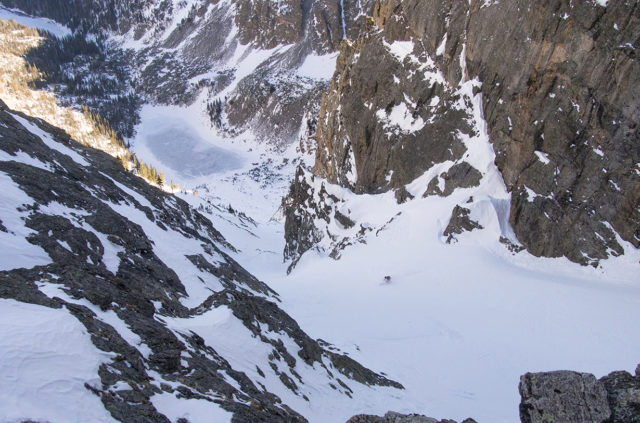
So, Cy, though I respect your take on the best ways to cut weight in your ski-touring setup, I personally disagree in a few ways. My primary area where I disagree is in regard to cutting weight in boots rather than skis. However, rather than simply arguing over the internet with Cy, I’ll tell you how I think about cutting weight in a ski-touring setup. Let the conversation begin.
Cutting Weight — Tradeoffs
Cutting weight in any part of your setup comes with tradeoffs. One of my favorite parts of Cy’s take is his section “Know Thyself.” Knowing your goals, skiing style, and personal preferences will make it easier to understand and prioritize the tradeoffs of cutting weight. In general though, here are the quick, general tradeoffs of cutting weight in major components of a ski-touring setup:
Skis: Lighter skis tend to be less stable at speed, less damp, and less predictable, particularly in challenging snow conditions.
Boots: Lighter boots tend to be softer (forward, lateral, and rearward flex), less durable, and have thinner liners, but they also tend to have a larger range of motion when in walk mode.
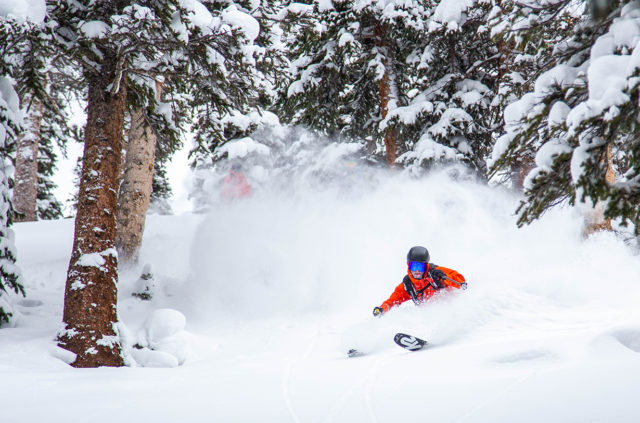
Bindings: Lighter bindings tend to give up features, many of which are designed to make binding release more predictable and safer. Though it’s difficult to objectively measure, lighter bindings are likely less safe and tend to also create a harsher, and less powerful feel on the downhill.
Packs: Lighter packs are almost universally less durable. Also, if you’re deciding between an airbag-equipped pack and one without an airbag, lighter packs without airbags will obviously not give you the option of flotation in the case of an avalanche.
Poles: Lighter poles are generally less durable. Adjustable-length poles tend to be heavier.
Now let’s talk about each of these pieces of equipment in more detail.
Skis
Skis are largely dictated by personal preference — everyone has a different skiing style, and as a result, a different preference in skis. There are, however, some general rules of thumb that I’ve come up with for my personal ski selection.
(1) Skis that weigh less than 1400 grams per ski in a ~185 cm length are almost always going to feel very light and twitchy. For everyday ski touring or ski mountaineering, I like to stay above 1400 grams for my skis. For me personally, 1500–1600 grams is a good target for a ski-mountaineering ski while a few hundred grams heavier tends to work well for mid-winter / powder touring. It’s not that my powder-touring days are always shorter than my ski-mountaineering days, but they are less consequential — doing 6 pow laps instead of 7 is much more palatable than missing a big mountaineering objective due to my skis being too heavy on the up.
(2) Super light + super stiff is almost always a bad combo for me. Generally, the stiffer the ski is, the more terrain feedback is going to be delivered to your body. And when that stiffness isn’t coupled with enough mass to counteract this effect, skis tend to get very harsh and unpredictable. When we get a <1600-gram ski that hand-flexes over an ‘8’ or ‘9’ for most of its length on our flex-pattern rating system, I try to stay away.
(3) It’s ok to go short. For inbounds skis, I typically reach for things in the 185-190 cm range. But for backcountry skis, where I generally ski slower and more conservatively, I’m typically happy with skis that are 5-8 cm shorter than I would usually ski in the resort. I just don’t need the extra stability that the longer lengths offer, and shorter skis are lighter.
Overall, picking a touring ski is very much dependant on how you intend to use it, but regardless of end use, those are the things I think about when reaching for a touring ski on any given day in the backcountry.
Boots
Just like in alpine boots, the single most important thing with touring boots is the fit. However, the fit considerations with touring boots are a bit different from alpine boots.
For touring boots, I tend to size them longer and wider than my alpine boots. I often wear touring boots for extremely long periods of time in nasty conditions and high-output exertion situations. Comfort is paramount for those boots. Adding to this idea, the time I spend walking / scrambling / bootpacking on a usual day in the backcountry is far greater than the amount of time I spend skiing downhill. So the super precise fit I seek in an alpine boot for maximum downhill performance is less important than the comfort I need in a touring boot.
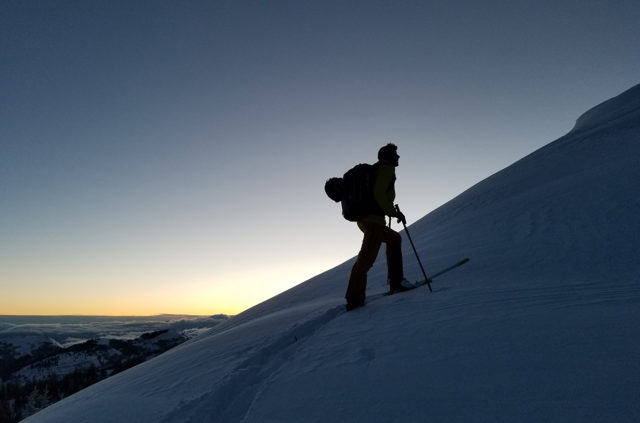
The lighter you go with boots, the more you lose in the form of the physical damping that heavier boots provide. Force = Mass x Acceleration, so the higher the mass, the more force it takes to move — the same principle applies to skis and bindings, too. Touring boots also tend to be made out of different plastics, specifically polyamide plastics rather than polyurethane plastics. Polyamide plastics tend to have a more energetic feel with lots of rebound whereas polyurethane plastics tend to feel more damp.
All that aside though, the big thing you lose in lightweight touring boots is support. There are several excellent boots in the ~1300-1500 gram range that are quite light and that maintain pretty good support, but once you start going below ~1300 g, forward, rearward, and lateral support all tend to become seriously compromised. And that’s a big problem for me (more on that below).
Bindings
Bindings have become a very hot-button topic recently. With several high-profile binding releases across all weight classes and binding discussion dominating more than its fair share of après conversation, everyone seems to have an opinion about touring bindings.
In general though, lighter bindings sacrifice features. Sometimes these features are designed to make the binding safe (e.g., quantified, certified, and adjustable release values) while others are designed to make them ski better (e.g., elasticity and alpine-like heel designs). When you cut weight on bindings, features have to go, which means that light bindings probably aren’t as safe and generally don’t ski downhill as well as their alpine counterparts.
I know that last paragraph sounds pretty damning for light touring bindings — that’s a lot of sacrifices to make. But it’s important to understand that idea in the context of how they’re used. Almost all of the time in the backcountry I’m doing one of two things: (1) trying to climb and ski a big peak or (2) trying to find good snow.
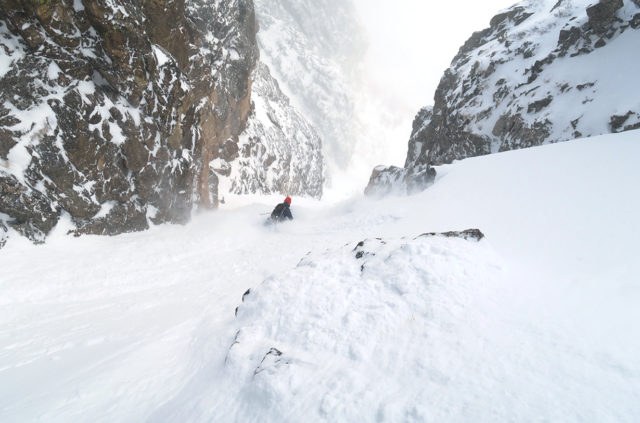
When I’m skiing big peaks, the most important thing on the downhill is to not fall, as falls can be disastrous in many of those situations. I’m also not charging down these big lines, and instead take a more conservative, slower, and cautious approach. As a result, retention is the most important factor for me in a binding I’ll use for big days, and things like release certification, elasticity, and power transfer are less important.
When I’m looking for good snow, it’s (ideally) going to be soft, whether that’s powder or corn. Point being, binding elasticity makes a negligible difference in soft snow where the suspension of the snow is far greater than the few millimeters of binding elasticity. To put this into perspective, just think about how it feels to ski a line in perfect pow vs. brutal refrozen conditions. Soft snow makes a huge difference in terms of terrain feedback.
I also tend to ski conservatively in the backcountry which means I’m less likely to take a dangerous fall, so safety-oriented features in a binding are less important to me in this scenario. Inbounds skiing is very different than backcountry skiing — I ski much more aggressively inbounds and therefore appreciate reliable release and power transfer much more in the resort. As we’ve mentioned, your mileage may vary. And with something like bindings, everyone’s personal risk tolerances will play a big role in this decision. Some may opt for the increased weight of heavier bindings, in exchange for more reliable release characteristics, while others might take the potential risk of a lighter binding, in exchange for less weight.
Packs
This one is pretty simple. Lighter equipment is great but it just isn’t as durable and won’t last as long as heavier stuff. Packs are a great example of gear that gets heavily used and abused and where lightweight constructions tend to get shredded pretty quickly. Lightweight packs also tend to strip down the suspension systems to shave weight, which makes them less comfortable, especially with heavy loads.
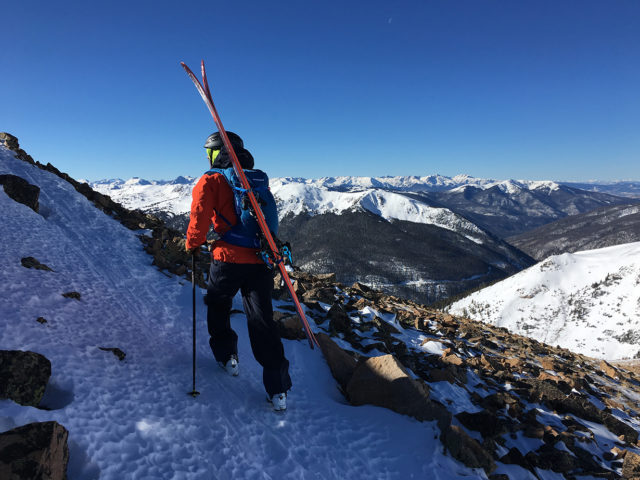
However cool that ultralight pack might seem in the shop, I think most people are better off going with a heavier and more durable pack that carries a bit better and should instead cut weight in the stuff they put in the pack.
Poles
You carry these dumb sticks in your hands literally all day long. It’s crazy, I know. But for something that we hold so much, poles get very little attention. Cutting weight in your poles can save a surprising amount of energy throughout a long day.
The easiest way to cut weight in poles? Go fixed length. Adjustable poles have far more material and hardware to adjust them — both of which add significant weight. Fixed-length poles are stronger and lighter. I tour a lot and have been using fixed-length poles exclusively now for several years. And you don’t need the absolute lightest, most expensive, and most carbon-y pole out there. I’ve been using the aluminum Black Diamond Expedition 1 poles for years and they’re still working fine (and are pretty light).
How I Think About Weight in My Backcountry Ski Setups
I’ve thought about this a lot over countless days in the backcountry and countless other days writing reviews of countless pieces of equipment (clearly, counting isn’t a strong suit of mine).
For me, I think about saving weight in my backcountry setups in a hierarchy — the higher up this list, the more comfortable I am with cutting weight for that particular item. I.e., I’m not as worried about the compromises I have to deal with when cutting weight in the items high on the list, while I’m less comfortable compromising on the items lower on the list. Here’s my list, arranged from best pieces to cut weight in to worst:
(1) Bindings
(2) Skis
(3) Poles
(4) Packs
(5) Boots
For me, boots are by far the most important part of any ski day. With a properly fitting and flexing pair of boots, I can get down the mountain safely on pretty much anything. Luckily though, there are some amazing boots on the market that cut huge amounts of weight vs. alpine boots and still ski amazingly well.
I’ve been skiing the Scarpa Maestrale RS (~1300 g for a size 25.0) for a few years and am completely sold on it. It is stiff, especially in the rearward direction, and offers all the support I need to ski hard while still having a huge range of motion and coming in at a very respectable weight. Any lighter than the Maestrale RS, and things start to get scary for me.
Bindings and skis top the list of best gear to cut weight in for me. That’s for two reasons: (1) cutting weight on your feet makes a huge difference on the way up and (2) there are light options for both of these that perform very well, in my opinion.
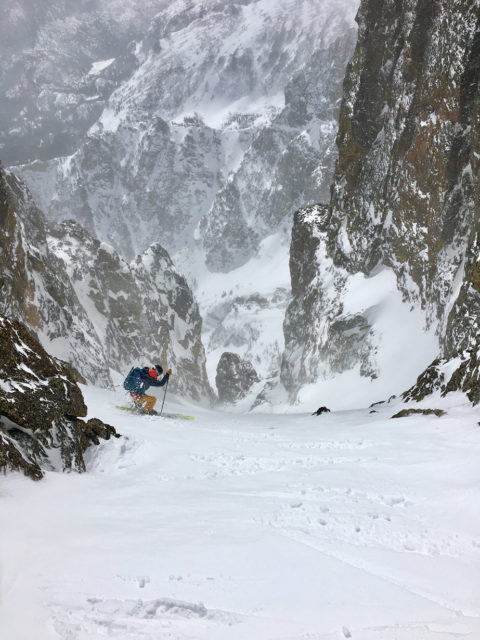
We’ve talked a lot about touring bindings on Blister and all that has left me with the takeaway that the downhill performance of a dedicated touring binding isn’t all that important. Sure, if you’re also pounding chairlift laps on your touring bindings, get a Shift. But for me and the backcountry skiing that I tend to do (see my notes above in the “Skis” section), downhill performance isn’t a huge deal in a touring binding.
I’m a full-on convert to the ATK Raider 12 2.0 / Hagan Core 12 as a dedicated touring binding. It’s an amazingly well-featured binding that is crazy lightweight and has excellent retention, in my experience. But it’s also very expensive and there are other great lightweight options that sacrifice surprisingly little and ski really well for how light they are (e.g., the G3 ZED and Marker Alpinist).
Skis are a huge matter of personal preference, but for me, the Salomon MTN Explore 95 proves that a ~1500-gram ski can be strong, predictable, and confidence-inspiring across a huge variety of terrain and conditions. It’s my go-to mountaineering ski. Cy had a different experience with that ski, but if I had to guess, I’d say that this probably has to do with our different skiing styles. Again, the “Know Thyself” concept is extremely important when it comes to dialing in your setup.
For powder touring, it’s all about fun. Shape and rocker profile tend to be more important to me than weight for these kinds of skis. Skis like the Folsom Trophy Carbon, Atomic Bent Chetler 120, and the G3 ROAMr 108 are some of my favorites.
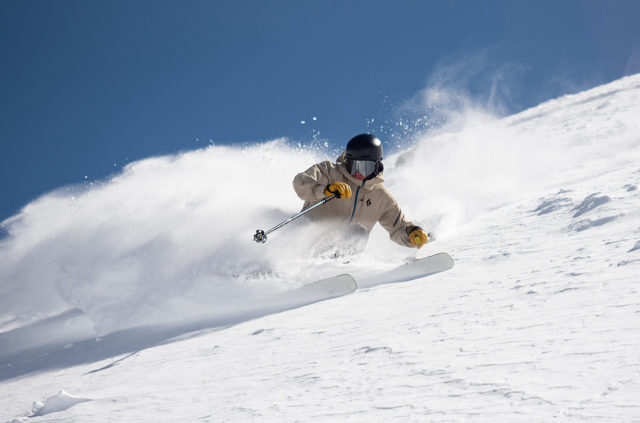
Those skis span a big weight and width range and are all more different than they are similar, but I think that illustrates a super important point about skis that we probably don’t make enough on Blister: in most cases, you will get used to your skis. You’ll make small adjustments over time and many people can get used to a variety of skis — and you’ll be a better skier for it. It is awesome when you find the perfect pair (and that’s why we provide personalized gear recommendations to Blister Members, so that you can find the right skis, bindings, boots, etc. for you). But at the end of the day, many people are going to learn to love their skis because most skis on the market are damn good.
Bottom Line
Although I talked a big game about calling Cy out, I guess I really only disagree with him on one point: I personally think the focus of cutting weight from your touring setup should be on bindings and skis, rather than boots. And although I’m totally, unequivocally, 100% right on this issue, please add your comments below about how you like to think about cutting weight. I look forward to arguing with you.
And then stay tuned for our other reviewers’ takes on this topic, which we’ll be publishing over the next few weeks.
Luke Koppa’s Take
Now that both Cy and Sam have offered their perspectives on this topic, I’ll try to keep mine brief. [Editor’s Note: Luke definitely failed in that regard.]
First, if you skimmed over it, go read the “Know Thyself” section at the top. That’s really the main point here — everyone’s preferences differ, and that’s why we’re adding the opinions of several of our reviewers.
For reference, my touring tends to be broken up into three different categories throughout the year.
From November to May, I’m mostly just searching for powder. These days tend to be in very inconsequential terrain, primarily due to the typically unstable avalanche conditions we see here in Colorado. Think tight trees, low-angle slopes, and ideally some features to fall off of.
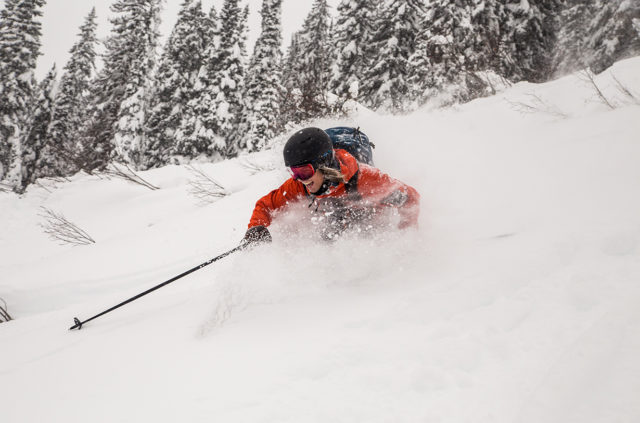
Then as the snow consolidates in the spring and early summer, my days transition to longer ones, seeking out steeper, more consequential lines.
I’ve also been skiing at least once every month for the past ~4 years, so I get to go on some often-very-long outings where the snow is hard to find, and usually really bad. From August–November, I’m hoping for at least slightly soft suncups, but most of the time the snow is really firm and really inconsistent (e.g., icy runnels and suncups the height of a small child, or bigger).
With that said, here’s how I tend to think about weight, where to cut it, and where to save it in my backcountry setups. I’ll also talk about the ideal setups I have in mind, but since we’re always testing new products here at Blister, I’ve included photos from many of the different setups I’ve been using over the past few years.
Skis
Based on the three different kinds of touring I do that I described above, my ski preferences differ depending on the time of year. Most of that comes down to the conditions I’ll typically see during different times of the year, but also the terrain and general length of the trips.
Mid-Winter Powder Touring
For this, I’m hoping to find at least some soft snow. Soft snow makes for a really forgiving ride down, which means I don’t care too much about having a super damp, stable, and heavier ski. And because I’m typically skiing in low-angle, tight terrain due to avalanche conditions, I’m not usually skiing super fast. Combine that with my preference to throw some tricks on little features, and I don’t want the stiffest ski for this time of year.
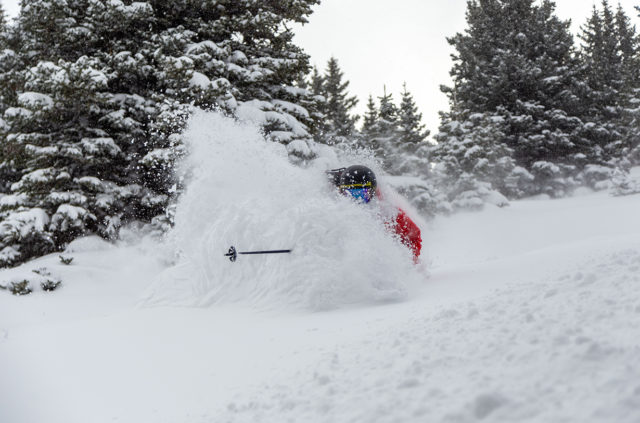
With all that in mind, I tend to like skis in the 1600-1700 gram range (for a ~180-185 cm length). While I wouldn’t want to ski any of these skis really hard in the resort, the soft, forgiving mid-winter conditions I’m searching for on these skis tend to make up for the skis’ lack of suspension.
Right now, the Line Vision 108 (~1615 g per ski for a 183 cm length) is my go-to pick for mid-winter touring. It’s very light which makes it easier to get out of bed in the morning knowing that I’m going to put in a lot of vert on the ski that day. But it’s also got a fairly soft, round flex pattern, a progressive mount point, and deep rocker lines. All of that equates to a ski that’s really easy to haul uphill, but that lets me take a more playful approach on the way down. And it floats well for its width.
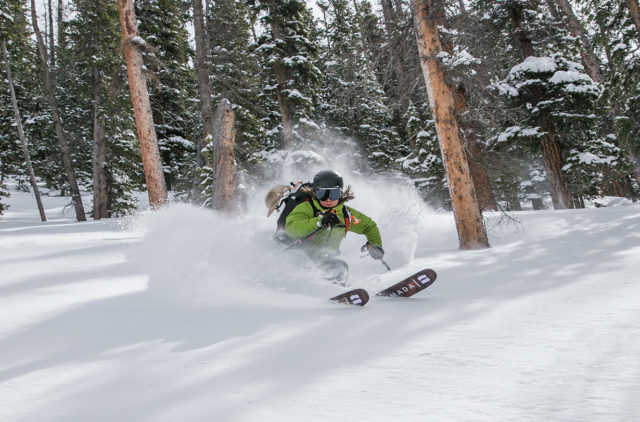
That said, if Sam or Cy ever relinquished the Atomic Bent Chetler 120 (~1730 g for the 184 cm), I’d probably be very happy touring on that ski during the middle of winter. But unless the snow is crazy deep, the Vision 108 offers enough float for me. I think I’d also be pretty happy taking out the new Line Sir Francis Bacon (~1880 g for the 184 cm) and Outline (~2028 g for the 186 cm) for a more playful ride, though I’d probably only bring those heavier, more freestyle-oriented skis on days when I know the snow will be deep and we’ll be sessioning jumps.
Spring Ski-Mountaineering
These days are very different than my mid-winter ones. In the spring, I’m looking for long, steep, and ideally fairly tight lines. These days tend to be longer which makes a case for a lighter ski, but the conditions are also a lot more variable. Sometimes I nail the timing and get to ski perfect corn, but I also end up skiing a lot of still-refrozen snow, which makes the case for going with a heavier ski.
In general, I find that I’m pretty happy with skis in the 1400-1600 gram range for this use. The Salomon MTN Explore 95 (1550 g for a 184 cm) is still one of my favorites — I think it’s really damp and stable for its weight, and I’ve found it to feel very intuitive (despite it being a pretty directional ski).
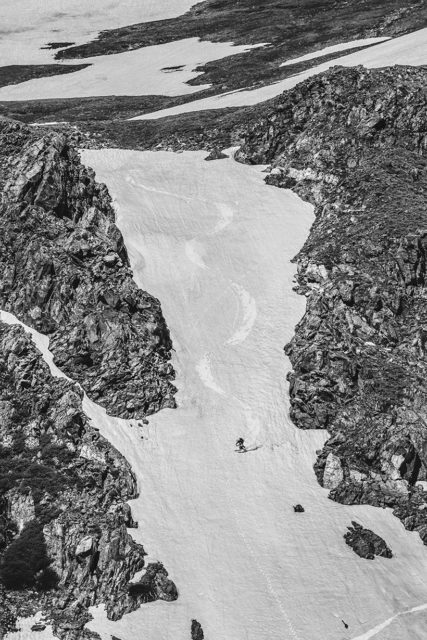
I’ve also started bringing out the Line Vision 98 (1446 g for a 179 cm) for these sorts of days, and it weighs a bit less than the MTN Explore. I’ll opt for the MTN Explore 95 for the more consequential lines (I trust its edge hold a bit more) or when I’m less sure about the conditions (and might appreciate its extra suspension / damping).
The Vision 98 comes with me on longer days, less consequential lines, on days when I am more confident about the snow being good, or if there’s an opportunity to build a jump (it’s much more playful than the MTN Explore).
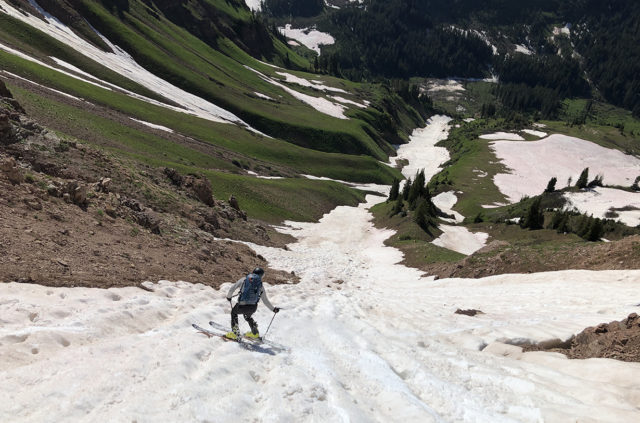
I could opt for a heavier ski that would feel more composed at speed or on nasty snow, but I’m very rarely skiing any of these lines particularly fast. Instead, I’m usually hop-turning my way down them, which means I’m never skiing very fast and don’t really need the extra stability of a heavier ski. And then there’s the factor of time — there’s often a relatively small window where certain lines are fun (or skiable at all), so having a lighter ski gives more confidence in my ability to get there in time.
On the flip side, these lines are also typically the most consequential of the ones I’ll ski throughout the year, which is why I tend to stay away from skis that are lighter than ~1400 g. Of the skis I’ve used in that weight class, I’ve found most of them to be difficult to ski and sometimes unpredictable. I’d rather have a slightly heavier ski like the MTN Explore 95 or Vision 98 that’s more predictable — predictability is a huge priority for me when it comes to bigger spring lines.
Masochistic Summer / Fall Missions
These days vary a lot. Around July and August we can still sometimes find snow that’s not too far from the trailhead, but other times we’re hiking 10+ miles just to get to the base of some tiny patch of ice.
For the short days (e.g., St. Mary’s Glacier), I don’t care too much about weight. If I’m only hiking a mile or two and not using skins cause there’s barely any snow, I’d rather bring a heavy inbounds ski with alpine bindings and have a ski that’s gonna be fun on the way down and make the likely-very-crappy snow feel a bit better. Right now, that’s typically the Line Sick Day 104, Line Sir Francis Bacon, or Moment Wildcat. But since these kinds of days are pretty low-consequence in terms of the terrain and distance, I’m not too picky in these scenarios.
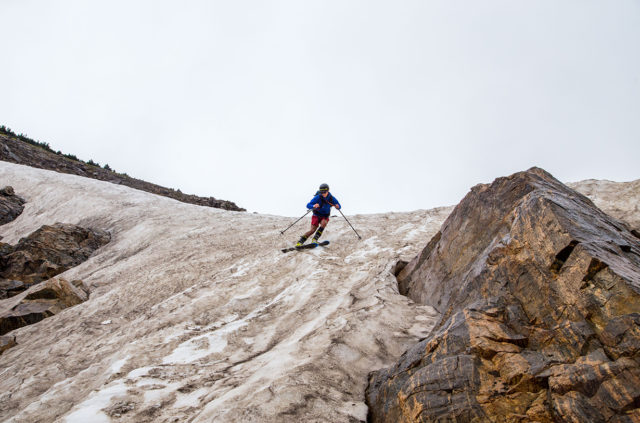
But most of the time the approach is really long. And usually the snow is so bad that we have to ski it really conservatively — no matter what skis we’re using. So this summer I’ve been bringing the Line Vision 98 a lot of the time. It’s very light and it’s very predictable. That’s really all I want when I know I’m gonna be spending ~98% of the day with my skis on my back, and the 2% of the day when I’m skiing is gonna be spent making slow survival-turns down terrible snow.
I’d be fine taking the MTN Explore 95, but it’s just a bit heavier and a bit less forgiving than the Vision 98, so I’ve opted for the Vision for most of my longer, more miserable trips this year.
I could go with something even lighter like the Fischer TransAlp 90 (~1250 g for a 176 cm), but I haven’t been on any skis that light that are as intuitive and predictable as the Vision 98 and MTN Explore 95. When skiing huge suncups and runnels, I want a forgiving ski cause my form is almost guaranteed to be absolutely horrendous. And I don’t want my skis putting me on my ass when a fall would mean sliding into a talus field at the end of the patch of snow.
Bindings
As Sam noted, bindings have been getting a lot of attention lately. There are now a ton of really cool, innovative options out there. But after skiing a lot of them, I’ve found that I’m not personally all that picky when it comes to a touring binding. Here’s how that corresponds to the different kinds of touring I typically do.
Mid-Winter Powder Touring
This is where I’ll go the heaviest with a binding. While the snow is typically very good and I therefore don’t need a heavy binding to help mute out harsh impacts, this is also when I’m skiing the hardest / fastest. It’s also when I’m building jumps, and therefore want more reliable release characteristics and durability.
Because of that, I’ll typically opt for a Fritschi Tecton, Marker Kingpin, or Salomon / Atomic Shift. I think the Cast Freetour system could also work really well here, though I haven’t used it.
The Tecton is my first choice for most days. The main reason I wouldn’t use it for everything is that I’ve cracked the heel piece during a botched 360 (due to a ski edge hitting the heel piece). It was covered under warranty and a new heel piece was promptly sent my way, but I’m more confident in the Kingpin and Shift when it comes to durability.
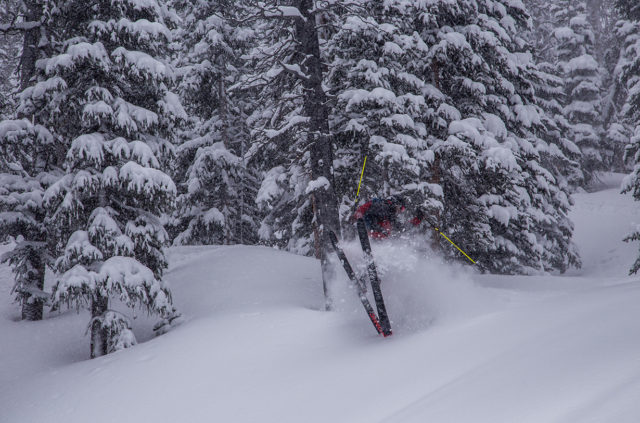
For days when I know I’m going to be sessioning a jump, I prefer the Shift. I don’t like it all that much for skinning (yes, I’m one of those people who still uses a high riser. Like, a lot). But on booter days, the skin track usually isn’t too long and I’m often hiking more than I am skinning. Add on the Shift’s certified release in the toe and heel, and it’s a pretty easy choice (because, odds are, I’ll be crashing a lot on those days).
I still really like the Kingpin — it goes uphill better than the Shift, I like its risers a bit more than the Tecton’s, and the Kingpin is quite good on the down. But for the days when I’m not hitting jumps a lot, I prefer the Tecton as it’s a bit lighter and its risers are still pretty good.
Spring Ski-Mountaineering
Since these days consist of a lot of walking / skinning and slower, more conservative skiing, I’ll go lighter with my bindings. I can get along pretty well with most of the bindings in the ~280-400 g range, including all of the ones we included in our Lightweight Touring Binding Shootout.
If the day involves a lot of skinning, the Salomon MTN / Atomic Backland Tour or ATK Raider 2.0 12 / Hagan Core 12 are my top picks. They’re really light (~298 g & ~321 g per foot, respectively), they have amazing climbing risers, and their downhill performance is fine for making hop-turns down steep lines.
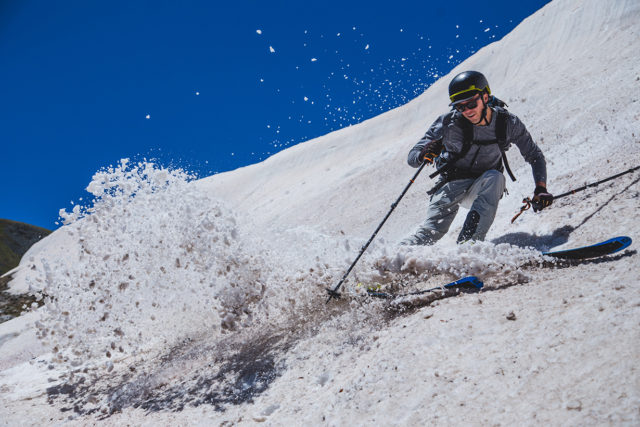
If the day doesn’t involve much skinning and instead more boot packing, I love the Marker Alpinist. It’s a bit lighter than those other two at around 284 g, it’s really good on the downhill for how light it is, and if I’m not skinning a lot, I don’t care too much about its lack of a really high riser.
That said, I could also happily use the G3 Zed for this type of touring (and have been this summer). As I said, I’m not too picky when it comes to bindings, and all of the options I’ve tested in the ~280-400-g class work pretty well.
Masochistic Summer / Fall Missions
Pretty much everything I just said about spring ski-mountaineering applies here.
Since I’m rarely skinning during these days, the Alpinist would be my top pick for the reasons mentioned above. But any of the bindings in that class would work.
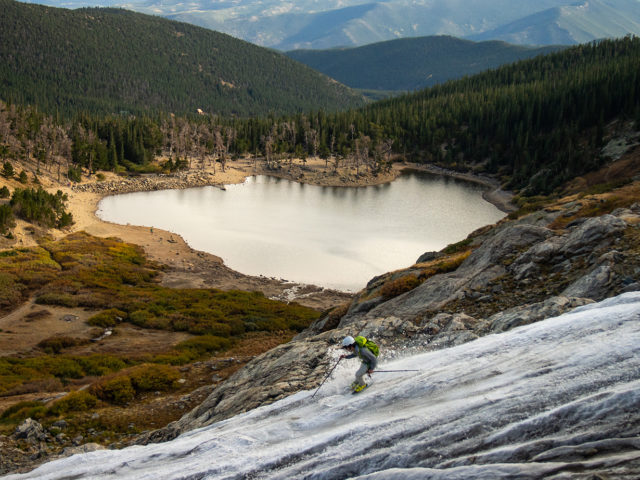
While I could go even lighter and into the ~100-250 g range, I haven’t used any of those bindings. Apart from not having experience with them, I’m mostly just worried about durability. Because having a binding break when you just hiked 10 miles to get to a stupid patch of snow would really suck.
Boots
When it comes to boots, my preference doesn’t change as much throughout the year, compared to skis and bindings.
For mid-winter powder hunting, I’m a bit more inclined to go with a heavier (~1800-2000 g) boot like the Nordica Strider 120, Salomon QST Pro 130, or Dalbello Lupo Pro HD. But since I’m usually skiing good snow at slower speeds than I would in the resort, I’ve still ended up taking out the ~1320 g (size 26.5) Tecnica Zero G Tour Pro for the vast majority of my days in the backcountry over the past two seasons.
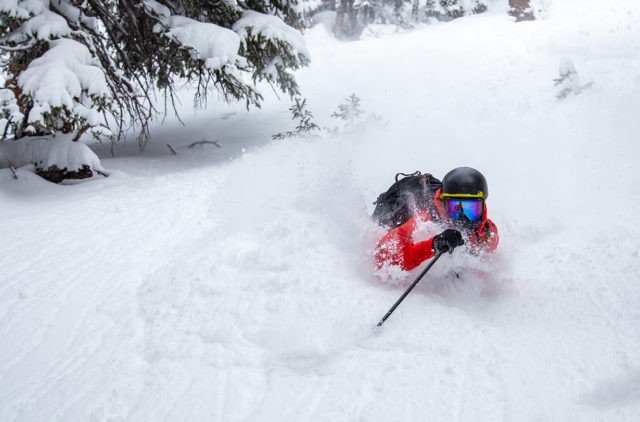
If I know I’m just going to be sessioning a jump that doesn’t require a long approach, I will take out the Strider 120 or Lupo Pro HD. They don’t walk as well as the Zero G and are significantly heavier, but they feel just a bit more “solid” on the down, which I appreciate when I’m trying to hype myself up to hit a jump. They also fit my feet a bit more securely. For booter days, it’s more about me feeling confident and comfortable, rather than quickly getting up to the top of the line.
But for everything else, the Zero G Tour Pro is plenty stiff for me, it walks incredibly well, and its progressive flex feels really intuitive to me. The Atomic Hawx Ultra XTD 130 and Scarpa Maestrale RS are other great options that’d I’d consider, but they don’t fit my feet nearly as well as the Zero G, which makes it an easy choice.
I haven’t spent much time in many of the lighter (<1300 g for a 26.5) boots, but I have skied the Salomon S/Lab X-Alp. I was surprised by how progressive its flex pattern was, but I didn’t feel nearly as confident skiing it as I do in the Zero G, Hawx Ultra XTD, or heavier boots. Plus, the X-Alp didn’t fit my feet well, which added to the issue.
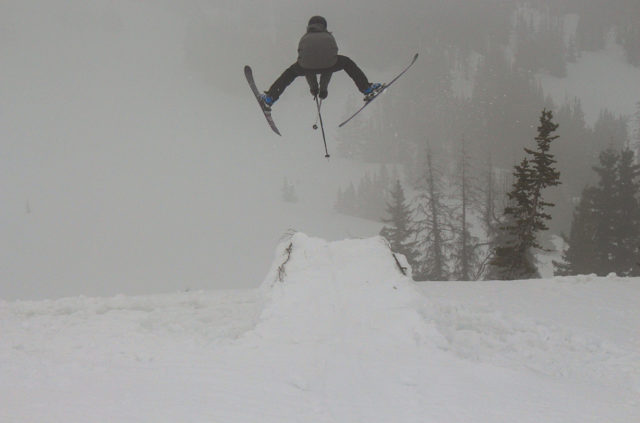
If the Zero G didn’t work so well for me, I’d be more inclined to experiment with lighter boots like the X-Alp for my spring and summer trips (I’d still stick with a boot like the Zero G for mid-winter days). But at least for me, the Zero G walks well enough and is light enough for long spring days, and I’m usually spending most of my summer days in hiking shoes, rather than ski boots, so I don’t need some ski boot that walks like a hiking shoe.
As for heavier, more 50/50-oriented boots like the Strider, Lupo Pro HD, Tecnica Cochise, etc., I don’t see a need for them for most of the touring that I do, apart from the occasional booter session. If I’m not lapping a jump mid-winter, I’m usually spending a lot of time on the skin track and not skiing super hard on the way down. Because of that, I much prefer to have a lighter boot that walks better and that might be slightly softer on the way down.
So at least for now, the Zero G Tour Pro is the boot I use for the vast majority of my days in the backcountry.
Other Gear
Backpacks
I’m with Sam on this one.
I’ve used a few very light packs, and they often lack features that I personally deem borderline-necessary, such as A-frame and diagonal ski carry, helmet carry, multiple pockets, and a good suspension system. And as Sam mentioned, lighter packs tend to get shredded a lot quicker than heavier packs with burlier fabrics.
Mid-winter, I like to bring a fully featured airbag pack like the Scott Backcountry Guide AP 30. While there are lighter packs out there, most of them are less durable and that Scott pack has all the features I want.
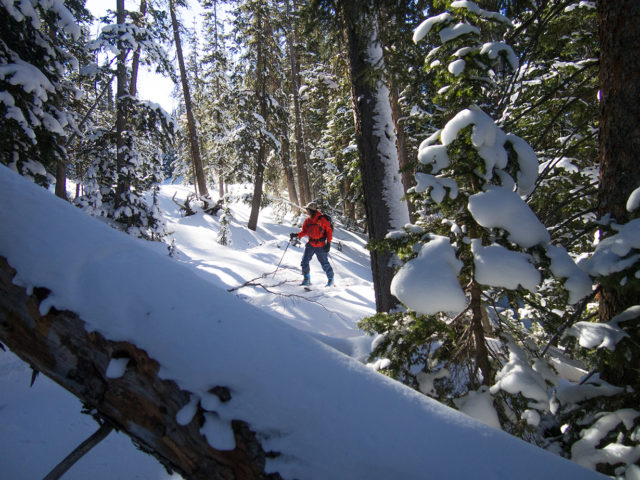
During the spring and summer, the snow is generally more predictable (so I don’t tend to bring an airbag pack) and I’m more worried about carrying my skis (and sometimes, boots) on my back for extended periods of time. Again, I could go with an ultralight pack, but I prefer to cut weight in the things in my pack, and stick with a heavier pack that will provide a more supportive suspension system.
For me, that means the Mystery Ranch Saddle Peak. It’s compact, durable, and most importantly, it’s got the best suspension system of any pack I’ve used in this category (~25L ski packs). That makes a big difference when I’m carrying skis and boots on my back all day.
Poles
I don’t spend much time thinking about poles. Most of the time I’ll just bring a fixed-length pole that I’ve been using inbounds. Some options I’ve used that are fairly light are the J Skis Titanal Pole, Zipline Blurr, and Leki Spitfire S.
I used to think that, in order to be a real backcountry skier and do real backcountry skiing on real backcountry mountains (see below), you had to have adjustable-length poles.
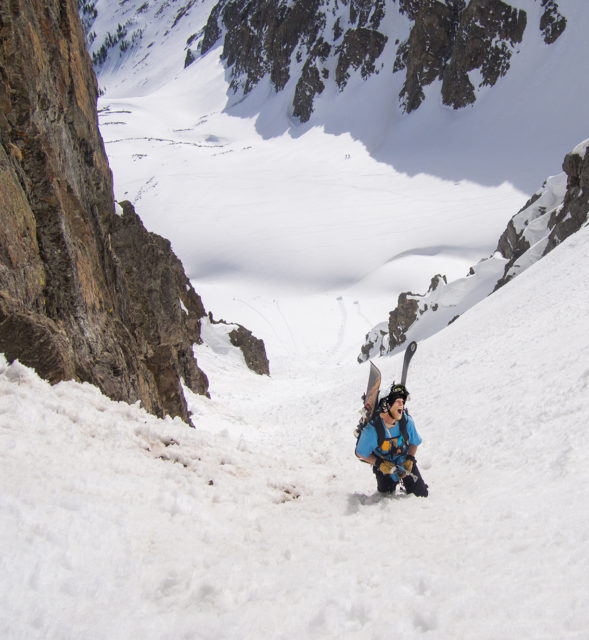
Nowadays, the only time I’ll bring adjustable-length poles is either (1) when I’m camping and packability is important, or (2) when I want a Whippet with me, which currently only comes in adjustable-length options.
I will admit that having an adjustable-length pole is nice when side-hilling and boot packing, but at least of the adjustable poles I’ve used, that doesn’t make up for the weight penalty and greater potential for durability issues (due to more moving pieces).
Skins
My go-to skins tend to be on the lighter end, but weight itself is not a huge priority for me. Rather, I like faster / less grippy mohair and mohair-mix skins, and those tend to be lighter than slower / grippier nylon skins.
So for me, efficient gliding is more important than low weight, and the fact that the faster skins I tend to use (Black Diamond Ultralite Mix, Contour Hybrid Mix, Pomoca Climb 2.0) tend to be on the lighter end is just a bonus.
Apparel
Weight isn’t a huge priority for me when it comes to apparel, mostly because I don’t tend to notice the weight of apparel that much. This is probably due to the fact that my apparel’s weight is distributed across my body, rather than being consolidated in one place like skis, bindings, boots, etc. where the weight is more noticeable.
For a touring shell, I find options in the ~350-650 gram range (size Medium) to be fine. That’s a big range, but apart from really long days, I usually prioritize breathability and fit over weight. I won’t wear some giant, burly inbounds shell cause in the backcountry I don’t get much benefit from the heftier weight and increased features. And I won’t go much lighter than a jacket like the Patagonia Ascensionist or Black Diamond Helio Active Shell (~365 g size Medium) because I’ll start to worry about durability.
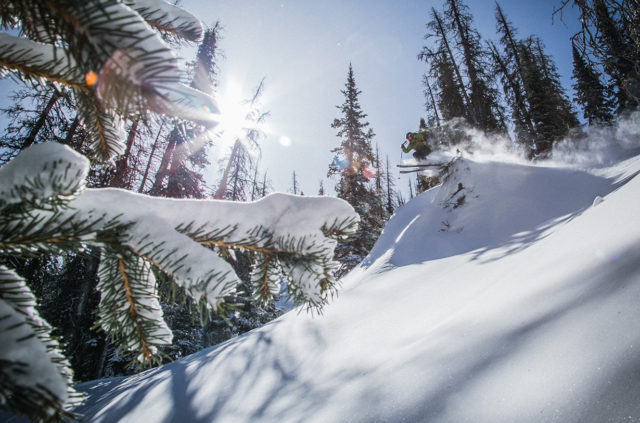
For my pants, weight is even less of a factor than in shells. While I’ll sometimes toss my shell jacket in my pack, I’m never taking off my pants in the middle of a tour (if you do, I hope you tour in zones that aren’t that popular…). Because they’re always on my body and never in my pack, I don’t really notice the weight of my touring pants. I’ve spent a lot of time touring in somewhat-heavy inbounds pants like the Open Wear Open One 3L pants (555 g for a Medium), but my favorite touring pant is still the Norrona Lyngen Hybrid (538 g for a Medium). The Lyngen Hybrid pants aren’t particularly light, but they’ve got really useful features and breathe exceptionally well, two things that are more important to me than weight when it comes to touring pants.
One piece of apparel where I do prioritize low weight is my insulator(s). These tend to stay in my pack most of the time, so their weight is noticeable. And a lighter puffy tends to be more packable, and pack-space is limited. So I tend to look to very light down and synthetic puffies to toss in my pack for transitions and emergencies. Because they’re basically as light and warm as down pieces, but more water resistant, the Patagonia Micro Puff and Macro Puff have become my go-to insulators for touring.
A heavier insulator would be more durable, but since I’m only breaking out these pieces for brief periods of time and am pretty careful with lightweight apparel, I’m happy to deal with a less-durable piece in exchange for less weight and more space in my pack.
Ok, I think that’s finally it for me. Stay tuned for our other reviewers’ perspectives on this topic, which we’ll be publishing over the coming weeks.
Paul Forward’s Take
I spend a lot of time in the backcountry each year, and have had the chance to ski a really wide range of backcountry gear — from ultralight boots (e.g., Scarpa Alien RS) and skis (e.g., DPS Tour1 Lotus 124), to much burlier setups like the Lange XT Free 130 boots and the DPS Alchemist Lotus 124. Here’s my take on where I personally like to cut weight from my setup, and where I prefer to keep it.
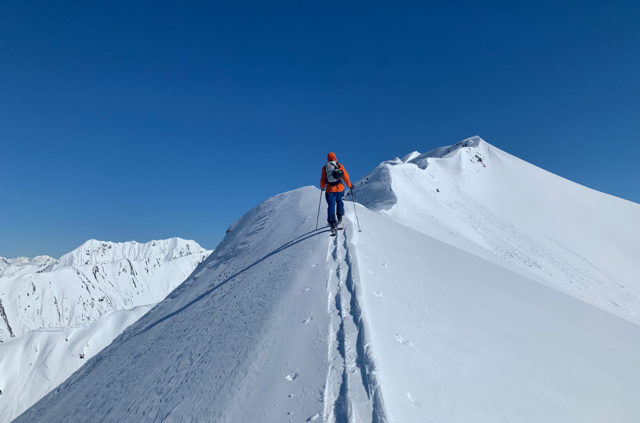
Skis and Boots
I love lightweight touring boots and I generally get along well with lightweight touring skis, but I will always place priority on boot performance, and would much rather shave weight off of my skis than my boots.
I’ve been playing with boots like the Dynafit TLT5 Performance since that boot first came out (around 2010, I think?). I spent a lot of time and money getting those boots dialed (in terms of fit and mods to make them ski better), and for several seasons, they were my everyday touring boot — even when I was routinely touring on >130mm-underfoot skis. Since then, I’ve spent a fair amount of time in just about every lightweight touring boot on the market. And despite all of that experience with lightweight boots, I would much rather gain a few hundred grams in my boots than in my skis for all-around skiing performance.
Cy writes, “In my experience, a heavier ski often makes a bigger difference in downhill performance than a heavier boot, so I prefer to save weight on my boots and use those weight savings to justify having slightly heavier skis. A great skier can get away with super light skis, but for most of us, those super light skis get really, really challenging to ski if the snow is anything less than perfect.”
After reading that, a friend (who has raced and coached alpine and nordic skiing at a high level and who routinely tours on super light gear) and I did a thought experiment on all of our friends and the gear they use and what they’d look like on both mild and extreme examples of Cy’s take.
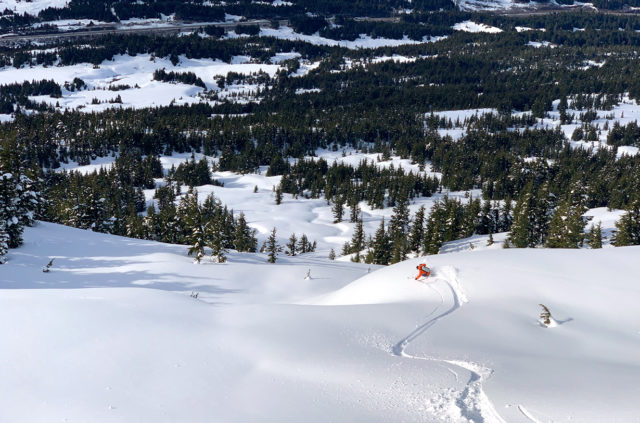
One of our regular ski partners is a former US Olympic mogul skier and to this day, he is one of the most balanced and beautiful skiers I’ve ever seen. If you take Cy’s point to the very extreme and imagine even someone like him trying to ski anything challenging in an 1100-g 2-buckle touring boot and a pair of super heavy skis (e.g., 193 cm Volkl Confession) … it would be pretty ugly.
Now, reverse this extreme scenario and put him in his alpine boots with a pair of 1000-g carbon rando skis, and I guarantee you he is going to hammer out fast precise turns in just about any terrain. He won’t love it and it won’t be fast, but he’ll drive and bend those carbon sticks until they blow up!
[Editor’s Note: To be fair, Cy was talking about a fairly moderate weight range when he was describing his perspective and preference to cut weight in his boots rather than his skis, and was not proposing people should ski a 2400+ g ski on 1000-g boots.]
On the other end of the spectrum is my wife. She is around 110 lbs and started alpine skiing in her mid-20’s, but she has nordic skied and raced nordic since childhood. She’s a fairly balanced skier and enjoys a wide variety of terrain, but is conservative with her speed, generally just enjoys getting out and skiing, and would be the first to tell you that she’s not an expert skier. She enjoys skiing inbounds, but prefers touring. Recently, in an effort to lighten up her touring gear, we bought her some lighter boots — the Atomic Backland (non-carbon version). She was coming off of a pair of old Scarpa Diva’s and she rides lifts in the Dalbello Chakra 95. Even with her fairly heavy pow touring skis (her beloved Moment Reagan), she found her Backland boots initially to be almost unskiable, and it wasn’t until we got the stiffer tongues that she started to enjoy them. In her case, we didn’t have to add mass to the boot, but adding stiffness made it possible to drive her big skis when touring. There is no way that going to even heavier touring skis would have fixed the problem. In contrast to Cy’s point, the only time that she felt okay in the soft-tongued boots was when she was on her other, much lighter touring skis, which she finds easier to turn, even with the soft boot.
And then there’s my personal skiing experience. I’m a 190-lb guy who skis a lot, often with a pack, and am always trying to improve my ski technique but still have a long way to go when it comes to optimal form [Editor’s Note: Paul is being humble here — he’s an excellent skier]. I tend to be pushing into the tongues of my boots / front of my skis a lot of the time, but am learning to ski more neutrally, and I still spend a decent amount of time getting pushed into the backseat when the snow gets weird. As I mentioned above, I tend to push lightweight boots to their limit, and I still use them with much bigger skis than is typically recommended.
The first time I noticed the limitation of my Dynafit TLT5 boots was when I did back-to-back runs on the same slope, switching between my (gen-1) 192 cm DPS Lotus 138 and the similarly shaped but much heavier 196 cm Praxis Protest. While I was fast and confident on the lighter Lotus 138, I could feel the light boots torquing and flexing in weird ways while trying to control the big Praxis Protest. The increased mass of the Praxis definitely did not make for a better experience in my light boots, but rather the opposite.
Since then, I’ve had the chance to directly compare heavy and light skis of the same shape; most notably, the DPS Lotus 124 in both the Alchemist and Tour1 constructions and, like Cy, the (190 cm) Moment Wildcat Tour and standard Wildcat / Blister Pro. I can say without a doubt that I would much rather use a heavier, stiffer boot and the lighter skis than use a lighter boot and the heavier skis.
I’ve skied the DPS Tour1 Lotus 124 with boots as light as the Scarpa Alien RS and as burly as the Lange XT Free 130, and quite a few in between. I’ve also skied extensively on the Alchemist Lotus 124, which is one of my all-time favorite skis. (There is a ~500 g difference between the two constructions.)
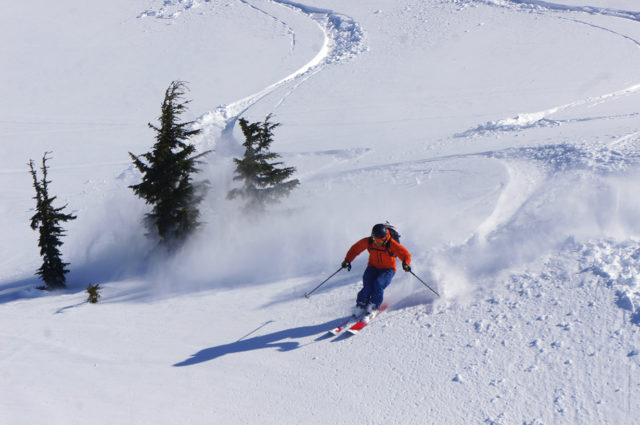
For any run, whether from lifts, a heli, or skinning, I would way rather be on the DPS Tour1 124 with a bigger, stiffer 500g-heavier boot than riding my all-time favorite Alchemist Lotus 124’s with a 500g-lighter touring boot.
For an even more “apples to apples” comparison, take the Moment Wildcat Tour vs. Wildcat example (where there’s a 300-400-g weight difference between the two versions). I ski both frequently in the 190 cm length. Just as with the DPS Lotus 124, I’d happily ski all kinds of terrain and snow on the Wildcat Tour and an ~1800-g Lange XT Free boot than I would the regular / heavier Wildcat Pro in the ~140-gram-lighter Maestrale RS. Both combinations would be fine for anything I do, but I have found that I can get way more performance out of the heavier boot + lighter ski combo.
I do concede that, currently, it does seem easier to achieve good performance from lightweight ski boots than with lightweight skis — especially at the extreme ends of the spectrums. Based on what’s been happening lately, I think it’s more likely that we’ll see a ~1200-g boot that performs like a World Cup race boot than we will a 1200-g ski that rides like a World Cup racing ski. Maybe someday we’ll all be ripping around on super-light, super-high-performance boots, and the weight of our skis will be the major weight variable affecting overall performance, but we certainly aren’t there yet.
So to sum up my take here: I personally don’t think that most skiers should shave boot weight so that they can tour on heavier skis. My opinion is that you should pick a ski boot that fits great (most important characteristic by far), has the flex characteristics that you want, and has the weight & uphill-oriented features that are consistent with the kind of skiing you want to do. Then find a ski + binding combo that similarly matches your goals. If you feel like you want to boost the downhill performance of your setup, I’d personally opt to focus on a better-performing, better-fitting boot, regardless of its weight.
As always, this comes down to knowing yourself, your priorities, and your preferences. Cy has gotten along very well with the light boot + heavier ski combo, while I am obviously quite the opposite. So the safest bet is to try to demo some boots and skis that span across the weight spectrum and see where you fall.
Poles
After many years of touring on adjustable-length poles, I have been spending more and more time in the past few years on fixed-length poles. They are lighter, seem to be more durable, and I don’t miss fumbling around with the occasional loose lower section and subsequent collapse. I shave further weight by cutting off the pole straps, which I rarely find useful anyway. I do still grab adjustable poles if I know there’s going to be a long, flat approach on the day’s tour — especially if I think there’s a chance I can skate-ski some of it.
Packs
As Sam and Luke allude to, pack failures due to durability issues are a bummer, but I rarely have any issues except for the occasional blown zipper. The only time I get cuts and other damage to pack fabric is from ski edges, but for mid-winter touring in Alaska, I rarely put my skis on my pack. So for those reasons, I generally prefer the lightest, simplest packs possible for ski touring. Give me a simple, single-compartment bag, maybe one zipper pocket on the outside, plus-or-minus an ample avy-tool compartment, and I’m happy.
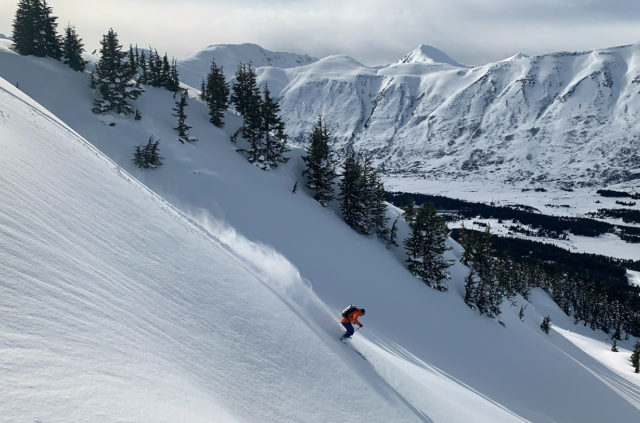
Also, as one of our readers mentioned in the comments, there are some packs that are very light and also very durable. I have used larger versions of the Dyneema-fabric Hyperlite Mountain Gear packs for a variety of adventures, and have found them to be superb in durability (except for ski-edge slices), not to mention that they’re almost totally waterproof. For me, the simple suspension of packs like that is more than adequate for any load I’d be carrying on a ski tour or shorter multi-day tour.
Other Stuff
Despite having spent an embarrassing amount of time and money trying to shave weight from my gear for winter and summer adventures, I am even more embarrassed by how often I end up with a bunch of old food and other rarely used gear accumulating in my packs throughout the year. I’d probably be much better served pulling out the eight to ten ounces of fossilized food or random mismatched extra gloves a few times per season, rather than buying a newer, lighter pack. If I was serious about keeping things light, I’d do a full empty and repack on a regular basis. I think this is a useful thing to consider when you’re debating buying some new gear that’s only going to save you a few dozen grams — there’s a chance you could save a bit of weight somewhere else without having to shell out cash for new gear.

Great article.
the “know thyself” advice is really the key to all of this.
my buddy dave’s ability to scamper uphill without skins(short term, of course) is indicative of how active his feet and ankles are. he uses tiny, soft boots all the time. and he is a true fall line skier. plus, even his carving move is almost a jump turn. no need for a pile driver of a boot.
i am something of a lumbering oaf. i have found that as i got into more powerfull boots, my skiing improved greatly. being a lumbering oaf, i am always suffering a weight penalty. the up is gonna be a grind anyway… comfort, fit and control go a long way towards keeping it fun.
How much of a role do you think bindings played in this? Would the MTN Explore w/vipecs made these much more enjoyable in sub-par snow? Would the Bent Chetler 100’s with MTN bindings skied that much worse?
Hey Eric,
I think bindings play a much smaller role in overall ski performance than they do in safety. So no, the Vipecs wouldn’t make the MTN Explore that much more capable, and the MTN wouldn’t make the BC 100 that much less (if any). For example: The BC 100 with MTN bindings would still be more capable feeling underfoot than the MTN Explore with Alpine bindings.
What that swap would to is make me ski much more carefully on the MTN BC 100 combo since I know they don’t have as consistent of a release pattern ans the Vipec or an inbounds binder. So I’d ski a lot slower, not because the binding doesn’t feel great, but because I know if I screw up there’s a decent chance it won’t come off when I need it to. That all make sense?
And again, this is just all based on my personal priorities. Plenty of people ski big stuff on tiny bindings with the toes locked. I’m just a wuss with bad health insurance, so I don’t take that risk.
Great article and subject to discuss!
I definitely agree with ski weight, superlight skis are overrated :)
When it comes to boots I find that the forward and lateral flex isn’t too bad when going lightweight. But when you get to the size 29-30 shells that I use you tend to get quite a bit of twisting flex in the lower shell. Obviously this gets worse with wider skis, on 120 mm wide skis it is really noticeable. This also seems to weaken the plastic over time. My semi-light boots (Salomon MTN Lab, Dynafit Mercury, etc) lasted about 40 days each, after which they were too soft. My even lighter boots have been used pretty much just for touring on very light setups so seem to hold up better.
Is this an issue any of you guys have experienced?
A binding like the Fritschi Tecton solves most of this, with good connection to the boot at both ends I don’t really have any issues at all.
Having skied superlight bindings quite a bit lately I really like them, and don’t think they give much up compared to a midweight binding. Really to get noticeably better skiability I think you gotta go all the way to a binding with either a toe-piece that dampens the ride (Radical2, Vipec) and/or get an alpine-like heel (Tecton, Kingpin, TR2).
Most impressive binding i’ve tried so far is the Skitrab Gara Titan, weighs next to nothing and skis great. Also quite impressed by my old ATK Raider 12 that seem to never give up :)
Hey Gunnar,
On the boot front, interesting! I ski much smaller boots (26.5’s) so I haven’t really noticed that issue. Wouldn’t be surprised at all though. As those shells get bigger it makes sense that the forces on the same thickness of plastic get stronger.
On the binding front, I totally agree. Personally I don’t really see a need for most of the mid range bindings (Old Radicals, G3 ION, MTN with brakes, etc) just because they’re not that safe, and they don’t really ski that much better than the lightweight stuff. And that’s reflected by the bindings I talk about in this piece. I totally see a place for the simple, bombproof stuff like the MTN, or the light bindings you mentioned, as well as something a bit safer, a bit heavier, with a bit better ride quality like the Vipec, and then something like the Shift that is as safe as an alpine binding. But if you’re going to weight more than an MTN, I feel like you need to be a lot safer, and have a lot better ride quality, and plenty of bindings don’t have that.
Anyhow, interesting imput, thanks!
Interesting discussion. I have a 29 size boot as well and wear the Salomon MTN Explore and have never noticed this. I’m quite light though (150 lbs), especially for that boot size. I’m pretty sure that weight plays into this as well. Same material thickness, bigger plastic area and more force (through more weight) will probably lead to more deformation.
How heavy are you Gunnar?
I weigh 180 lbs and am 6’2 so that will certainly make a difference. Being tall I tend to often ski longer skis as well. Also, for some reason I wear down boots faster than most. Bindings and skis tend to hold up fairly well for me though.
Since the post above I put a Palau lightweight (but fairly stiff) liner in my Cochise boots. Initially that liner was intended for my Atomic Backland Carbon boots. Put I struggled to get that to work properly so tried those liners in the Cochise. A nice weight saving of a little over 300g per boot over stock liners, and skiability stayed remarkably similar. Pretty excited to see how those hold up over the coming winter!
Also, if anybody has recommendations for lightweight touring boots I am all ears :) I have quite a bit of testing to do on a new lightweight 101mm ski this fall and winter and need the appropriate boot for that. Testing with stiff boots doesn’t give me representative testing for how most customers will set up their skis.
Struggled with the Backlands being too low and not giving me enough support. Stiffness on those was fine though.
Bent Chetler 120 + vipec evo + S/lab x-alp
Bent Chetler 120 + Shift + XTD 120
Which setup would you prefer personally? Can you give any pointers on which kind of skier would prefer one setup over another? I realize that this also comes down to personal preference (up vs down), but do you think that going lighter would sacrifice too much of the downhill performance of the setup?
Joel,
Hmmmmm, that’s interesting. I’m riding the BC 120, Shift, XTD 120 train pretty hard right now, and I personally wouldn’t swap over, but I think many people would get along well with the lighter setup. Here’s why:
One of my favorite things to do in the backcountry is getting into the air. I like finding new cliffs to hit, and I like building booters. The BC 120, Shift, XTD 120 is the best setup I’ve ever skied with that in mind. Two reasons: On big compressive landings, I do notice boots a lot more, lighter boots have a tendency to not support my ankles as well on big landings, which is scary since I sprain my ankles a lot. Secondly, hucking and spinning is a perfect match for Shift. When I’m hitting a new cliff, or trying a new trick, I want alpine releasability and elasticity. Shift and Cast are the only options that give me that. So for me personally, I’d never give up Shift, and the XTD 120 on this particular ski.
But I think plenty of folks would love the setup you describe, especially if the BC 120 is the wider pow option in a two-ski touring quiver. If you’re not planning on hucking your meat, and you just want a light, fun setup for those deep days, the BC 120, X-Alp, and Vipec would be so much fun. I’m getting excited just thinking about it. As long as you’re predominatly skiing consistent snow (pow mostly, but this would be a fine, if overkill corn setup) the X-Alp should drive the BC 120 just fine, and that setup would be a dream on the uphills.
So no, it wouldn’t sacrifice too much of the downhill performance, for a lot of folks. However, the BC 120 with Shift and XTD 120’s can totally double as an inbounds setup if you need it to. The lighter version, probably not so much.
For example, I’ve seen plenty of folks that have something like a DPS Lotus 138, with super light bindings (no brakes) and an Atomic Backland boot as their stupid deep day touring setup. For really deep backcountry days, especially if you’re skiing lower angle stuff, big fat pow skis, and tiny little boots and bindings make a lot of sense.
I am one of those people who keep my skis very close to the snow, and ski at moderate steeds.
So I have been thinking of a Bentchetler 120 with Tecton bindings as a 50/50 ski:
Inbounds, if it’s deep enough to want a 120mm ski, it’s going to be soft too. Tecton skis quite well and seems pretty safe. If it’s hard and rutted I wouldn’t be on a 120mm ski.
Touring, Tecton is only a bit heavier than Vipec, and tours efficiently. So it would do great for mid-winter, high risk days were you are surfing low angle pow. If it’s a huge vertical day or multi day hut traverse in the alps, I’d want a narrower ski anyway.
That would be a rad setup. Nice!
Thanks for your input!
Most of my touring is done on pretty good snow. Otherwise I’ll just stay in the resort, lapping runs with a lift. I’m looking for a setup that is capable of a few drops with a powder landing (max 3m, I’ll rather use other setups for drops bigger than that), jibbing rocks and tree stumps and just having a good time in pow. I reckon that the Vipecs would still be pretty well suited for this? Would the tiny MTN be a tad too weak? Actually pretty stoked on the idea of having a small binding.
The problem is, I’d also like to use the setup for touring (very) soft spring slush. Should I just go narrower with the ski/get the shift/just go for two different setups.
Huge thanks!
Great info on here, really useful so thanks guys! I particularly like the ranges of opinions, just goes to show how there is no right answer :) I was wondering if you could maybe put each skiers weight and height next to their name though, it would just make comparisons a bit easier.
Interesting and valuable. As has been said, the “know thyself” advice is key. Not sure I agree on boots being where to cut weight. I’ve been alpine skiing for 65 years through every iteration and development of all skiing components and the biggest deterrent to an enjoyable outing of inbound or touring seems to focus on the boots. I don’t know how much time I’ve lost waiting for someone to adjust, undo, redo, or otherwise fuss with their boots but it’s been a lot. Getting boots that fit should be a lot easier now than in past years, yet why is it I still wait for the fussing? I recently upgraded my touring setup with G3 Findr 102s with their Zed bindings (from K2 Coomback 102s with Dynafit ST radicals) but I’m keeping my Dalbello Virus lite as they feel like slippers on my feet fully snugged up, and only require flipping the levers to transition. No buckles, straps, or tongues to mess with and they ski like the best Alpine boots I’ve had. They do weigh 3200 grams but are worth the extra in comfort and fuss-free performance.
Just bought the BC 100. Want to use it 75% touring and 25% inbounds. Not sure if I should mount Tecton (I’m a big fan of the Vipecs currently on my BD Helio 105), Vipec or something with less weight (ATK Freeraider?). Any suggestions?
Thanks!!
Tom,
I’d go Tecton or Vipec there for sure. If you’re going to be using a ski like that inbounds I personally really want a little “safer” / predictably releasing binding. But plenty of folks ski basic tech bindings inbounds and still have both ACL’s so I feel like that’s more of a personal “how much do you want to risk it” call.
How do you think the Bent Chetler 100 compares to the Fischer Ranger 98ti?
Would you say the setup Ranger 98 + vipec + X Alps is quite similar to your Bent Chetler 100 + vipex + X Alps?
Also considering skiing inbounds 2-3 times a year.
I guess the Fischer is more of a carving ski and the Atomic is better suited for you jumping, spinning freestyle folks :D
What do you think?
Thanks for the thoughts!
Also curious about this! I demoed the bent chetler 100 last year and really enjoyed it. Bought a pair of 18/19 ranger 98 ti recently and put the meidjo telemark binding from the m/equipment on it and would like to use it as a 50/50 inbounds/backcountry ski. Going on 2 – 3 trips a year, so can’t really justify/afford a two ski quiver yet. If I was able to tour more than I would consider purchasing the bent chelter 120 or raven, depending on which conditions I think I will be skiing the most.
Thanks, Cy!
Will buy Vipecs – love the handling a bit better than on the Tectons.
I once cut the handle off a toothbrush. Futile. Impossible to clean your teeth as you have nothing for leaverage/control. Much more sense to drill holes in the handle.
Very helpful and thought provoking article. For a 95% fresh snow touring set up I am veering towards BC 100 in 180 with very light bindings such as Marker Alpinists. I am 60 years old, and ski in a manner befitting that. 2 lots of my current skis have Dynafit Superlites and while not as plush or confidence inspiring as Beast 14’s, at least I can lug them uphill. Though 12 stones in weight (168lbs) I think the 188 would be a pain for me on technical uphill and intimidating downhill.
Strong callout Sam!
Although, after all my big talk last year, I ended the season skiing the Maestrale RS for everything as well. So…if the boot fits!
Your points about packs and poles are great. I can’t live without adjustable poles, so I’m SOL there.
I do wish somebody would make a pack that combined the suspension, features, and padding of my favorite Thule touring pack with slightly lighter weight materials. Might have to plug in the sewing machine and try to make it happen myself this year!
Stoked to hear Paul’s thoughts.
Great article, putting some perspective on decision making and compromises for touring set up. I am a little over reviewers that obviously have a hundred different ski set ups for every occasion.
The boot choice is going to come down to fit. The Atomic Hawks are a lot narrower than the Salmon’s.
Sam,
Regarding packs:
I agree that often lighter packs are less durable than heavier ones. That said, how much durability do you need? I have some very well used Wingnut packs made from very light fabric, and despite regular use, they are still going strong. Yes, the 500d Cordula on my old Granitegear packs is way tougher, but for many users it’s probably overkill. The same with the giant zippers.
Also with modern fabrics, you can get some very strong fabrics that are still lightweight. Hyperlight Mountain Gear being the prime example.
The other thing is that packs can be made lighter by using thinner, narrower webbing, which might compromise ease of use, but not durability.
And finally, there is the trade off in features and organization vs weight. This also does not affect durability.
Sam was right to add poles, but we still missed skins:
Lighter skins are obviously just as beneficial as lighter skis, boots or bindings on the uphill, and unlike those items, they are also better on the downhill (especially if they pack smaller, not just lighter).
Sam mentioned shorter skis for touring than for inbounds use, but how about narrower? Shorter, narrower skis use shorter, narrower, skins, so the weight savings in your total set-up is even bigger than just that of the skis.
Then, on skins themselves, what are your thoughts on the compromises of lighter vs heavier skins for a certain size ski?
Nylon vs Mohair?
Minimal vs full featured Hardwear?
Thin vs thick backing?
Skins shorter or narrower in tip or tail than skis vs wall-to-wall carpet?
It seems like there are now some boots that are aimed at the downhill that have great range of motion and are still quite light, and at the same time, some superlight touring boots that ski quite well.
Knowing that, I wonder if these days, the decision is becoming more about the quality of the stride, rather than pure weight and range of motion.
Even though some of these downhill oriented boots are pretty light, and have a good stated range of motion, they still might not hike and skin as well as more uphill focused boots, due to resistance in ankle flex, ease of transitions, length and rocker of the sole etc.
What do others think of that?
Really interesting article and comments here. One thing that really stands out to me/us is that many folks are pretty quick to give up binding weight because, in Sam’s words “I also tend to ski conservatively in the backcountry which means I’m less likely to take a dangerous fall, so safety-oriented features are less important to me in this scenario.”
While you may be less likely to take a fall in the backcountry, the consequences increase dramatically. And while it may make sense to go lighter for a longer touring mission it also means you will be that much farther out if injury does occur. Within the ski/boot/binding trio, bindings are the only tool that account for injury prevention and increase our safety. Prevention is always best practice. It is also important to note that the tech touring binding standard(ISO13992) does little to account for lower leg injury and thus increases the risk of this injury and ensuing rescue dramatically.
If we are trying to trim weight, it is likely best to not start with our tools for safety. But like Cy said it really comes down to a “how much do you want to risk it?” call.
It doesn’t matter how conservative your decision making is, everyone still carries full avy gear, right? (which also includes reliably releasing bindings)
Personally, I see the added benefits of binding safety and really appreciate the added dampening when you don’t quite find the conditions you were hoping for. Dec-April Setup: Atomic Hawx XTD, Cast Freetour, Praxis MVP (110)
I’d love to hear everyone’s thoughts on this perspective.
I think you have a valid point there, regarding the consequences of injury in the backcountry vs the resort.
But the big question remains whether tech bindings are really much less safe. Binding safety is a complex topic, and encompasses many aspects.
Certainly for earlier/mid season tree skiing there is something to be said for lateral release at the toe, as mentioned here in the Vipec review:
https://blisterreview.com/gear-reviews/2016-2017-black-diamond-fritschi-diamir-vipec-12
At the same time, the thought that many people probably are making is that their skiing style is much slower and more controlled, so crashes are far less violent, as well as less likely. The final part there is that such a skiing style, probably doesn’t require the same level of elasticity, so skiers can use lower release values even in tech bindings.
Thanks for the input — it’s always valuable to get different perspectives on this topic.
First, I want to again make it clear that this article consists of the collected opinions & practices of some of our *individual* reviewers, and shouldn’t be thought of as some categorical statement from all of us at Blister.
With that said, here are a few things I’d like to highlight:
(1) “Safety” happens on a spectrum. And it depends a lot on what the individual skier / boarder is comfortable with.
(2) We would not encourage anyone to head out into the backcountry on gear that they view as being undergunned, or not up to their standards when it comes to safety, durability, performance, etc.
(3) That’s also why some of us at Blister (e.g., me) have zero interest in ultralight bindings.
(4) Finally, in our experience, *all* bindings *can* develop issues. We’ve ripped the heel pieces of alpine bindings out of skis, cracked toe and heel pieces, had significant icing issues on AT bindings, etc. No system is absolutely immune from issues.
But that said, there are more binding options than ever on the market, and while some skiers (and some of our own reviewers) may disagree, I personally have never been interested in going out on the lightest bindings available, and I spend a lot of time getting familiar with and developing a trust in a binding before getting into highly consequential circumstances — whether that means getting far out in the backcountry, or skiing techy, consequential terrain.
I’ll be adding my own take on this topic soon to the article above, but my response here is, in a nutshell, my take on these things.
This is a great series, and it’s fascinating to hear about all the different perspectives. It has prompted me to try to “know myself” better, and figure out what I am really looking for in touring gear.
The whole safety/risk/injury/binding questions is a huge topic, and like others I’d appreciate more discussion. I do want to offer a surprising dimension that I rarely hear discussed.
Traditional alpine bindings, and touring bindings that release laterally at the toe, like the Vipec, are generally designed to protect against tibia fractures, but do little to mitigate soft tissue injuries (such as ACL tears). In contrast, there is some evidence that traditional pin bindings that release laterally at the heel do a better job or protecting against ligament damage, but may increase the likelihood of lower leg fractures.
(Note, I am definitely not stating the above as a fact, but as a possibility supported by some evidence and industry voices).
Check out the article linked below with the cringe-worthy title, “Ripping ligaments and snapping bones–tech binding release testing.”
https://www.wildsnow.com/15123/tech-binding-release-testing-acl-broken-leg/
It’s long and technical, but there’s a great deal of good information buried in the comments.
To me, the article makes sense. Also, I badly injured my knee and ankle with Vipec bindings, and have lost all trust in that design. So when I think about the “safety” of a binding, I’m looking for a traditional pin binding that releases at the heel, and then thinking about overall solidity and stability, elasticity and damping, additional features, and so on.
I guess that’s part of what makes it so interesting; we all have to figure out what works best for us.
For anyone who doesn’t want to read through the article linked above, here’s a summary, about as brief as I can make it. This is a generalization; there are many fine details and added levels of complexity in the article and comments.
Imagine that you mount a ski boot in a fixture and click into a binding on a ski. You suspend the book/binding/ski combination so that you can pull the ski to the side, producing rotational and lateral forces on the fixture in the boot. The fixture holding the boot simulates your leg. Holes are drilled in the ski at 5 cm increments to serve as anchor points. At each increment, the ski is pulled to the side, and the force required to release the ski from the binding is measured. It’s also possible to measure the forces on the fixture.
It’s natural to assume that, as you move from ends toward the middle of the ski, the force required to release the ski will slowly increase; at the ends of the ski the lever is longer and therefore less force is required to release the ski. This is what the data shows. However, as you approach the middle of the ski, the forces start to increase dramatically, and in a different way for bindings that release at the toe (alpine bindings and some touring bindings like the Vipec) and bindings that release at the heel (traditional pin bindings).
The reason is that in each type of binding there is a “blind spot” where you can apply a nearly infinite amount of lateral force to the ski, and it still won’t release from the binding. For bindings that release at the toe, the blind spot is located at the heel piece; you can’t force a boot sideways out of the heel piece without destroying the entire mechanism. For bindings that release at the heel, the blind spot is located at the toe piece; you can’t force a boot sideways through the toe piece.
Because of the differences in where these blind spots are located—at the heel or at the toe—the two types of bindings produce different forces on the fixture holding the ski boot (your leg). For bindings that release at the toe, the direction and magnitude of the forces on the fixture are similar to those that can injure soft tissue in the knee, such as the ACL. For bindings that release at the heel, the direction and magnitude of the forces on the fixture are similar to those that can break bones in the lower leg.
To each his own, but I’d rather deal with a tibia fracture than an ACL tear, hence my preference (now) for bindings that release at the heel.
Bruno, thanks for your comments and linking that article. In the Vipec review mentioned by tjaard, I also briefly talked about the content in the Wildsnow article. However, I’d ask readers to consider two things:
1) To a certain extent, you’re in control of how exposed you are to an ACL injury – the experiments were with the knee bent at 90 degrees, and with a lateral force near the heel – in other words, a backwards twisting fall. This is not a natural skiing position, so, to a certain extent, you’re in control of how exposed you are to the injury. The opposite is true for a tibia or ankle fracture – it occurs most often when in the natural skiing position.
2) The day-of consequences for a tibia or ankle fracture are severe, whereas the day-of consequences for most ACL injuries are relatively trivial. It’s extremely unlikely you can ski away with a fracture. It’s very likely you can ski away from an ACL tear.
To expand on #2:
1) On the day I fully-tore my ACL, I knew it was the ACL, skied down to the ski patrol shack, popped a few Advil, then skied the rest of the day – albeit much more conservatively. I continued to ski the rest of the season – again, more conservatively. While anecdotal, I know several people with similar experiences.
2) Many people, including my mother, opt to continue skiing without an ACL for the rest of their lives.
As CAST mentions, the day-of consequences are pretty important to consider when you’re in the backcountry, miles from any help.
I should clarify that I’m not saying Bruno’s decision is a “bad” decision. I’m just saying that the decision should not be as simple as deciding… would I prefer to deal with the aftermath of an ACL tear, or a tibia fracture? It’s definitely more nuanced and not quite as clear-cut.
Thanks Brian–that’s definitely an important perspective to consider.
My general point is that traditional tech bindings might have some advantages that are not often discussed. Another point is related to control; if a binding has a solid heel piece and more elasticity at the toe, like a Vipec, a case could be made that one would be less likely to fall in the first pace, compared to a traditional tech binding with a rotating heel and less elasticity, although my understanding is that the differences between bindings in this regard are minimal compared to differences in boots and skis.
In many ways, the more factor is that I’ve simply lost faith in the Vipec binding, however irrational that might be. I just don’t trust the bindings anymore. Here is a description of my accident and the binding function from another thread. This also highlights the huge (to my my mind) issue of how different boots and tech bindings interact, and how wear on all the components affects release function, and how a few millimeters or less of plastic or metal can make all the difference between a smooth release and an injury. This can be partially mitigated by careful testing, maintenance, and awareness, but I think the industry needs to do a much better job of regulating the “Wild West” market of varying touring boots and bindings, to insure that everything works as well as possible, so that people have less chance to suffer what can be devastating injuries.
I badly injured my knee and ankle skiing with a 2nd generation Vipec and a Scott Cosmos II boot. I lost control going over a small roller at medium speed, and my right ski twisted in a clockwise direction, looking down from skiers perspective–the front of the ski moved right, and the back of the ski moved left. I think the force on the toe was mainly lateral, although there was also significant compression. My leg was relatively straight–not bent at 90 degrees.
The toe of the binding released laterally to the inside. I know that because the left toe wing of the Vipec was open after the fall. So the Vipec carriage slid to the inside, and then the toe wing flipped down, and the boot released. However, the binding only released AFTER I injured the soft tissue in my knee and ankle I felt an intense building pain in my knee and ankle before the binding released, and knew even as I was falling that I had injured my leg.
The lateral release felt “catchy” or “sticky,” and it seemed to happen in two stages. There was a stage of great resistance, with little or no movement, during which I injured my knee, and then a sudden rough release, when I fell. The binding seemed to have little or no elasticity, and the release was not smooth. I don’t know how reliable my impressions are–-all the sensations were translated through the ski and binding and boot and my body. But that is how it felt–-no release at all with building tension and pain, and then a sudden, scraping, catching, release. It felt very different to the smooth and elastic release of an alpine binding. I believe, but I do not know, that my injury could have been lessened, or prevented, with a smother lateral release.
Were my bindings and boots functioning properly? Was the release I experienced completely normal, or was there some interference between boot and binding? Would I have injured my leg with a regular alpine binding, or a traditional tech binding with release at the heel? At this point, I don’t know. But I do know that I have lost trust in the Vipec.
Question regarding ski weight. Most often, ski weight is given for a pair, but what about individual ski weight? If a pair weighs 3500 grams total then what is an acceptable differential between the two skis to maintain weight balance? If one ski weighs 1700 grams and the other weighs 1800 grams that’s almost a 1/4 pound difference in weight between the two. Is having an additional 1/4 lb of weight on one ski going to cause a weird feel on the skintrack?
In general, a 100-gram difference between the left and right ski in a pair is not all that common, though we’ve definitely seen it in some of the pairs we’ve measured. That said, I’ve toured on some skis where the difference in weight between the left and right ski is close to 100 grams, and I’ve never noticed it. Maybe I’d notice it on an extremely long day, but even then, I doubt it would cause any notable issues.
I noticed none of the reviewers listed the 4frnt raven as a ski they use but Blister touts it as a their favorite all around ski for touring? Curious why. Does everyone agree it is a good ski but not anyones favorite ski?
Good question — the main reason for this is that Cy, Sam, Paul, and I have not spent much (or in some cases, any) time on the Raven. Jonathan and Eric Freson are very big fans of that ski, they just haven’t chimed in here yet. You’ll definitely be seeing that ski in some of our reviewers’ ski quivers though, which we’ll be posting in the coming weeks.
The key to happiness is to lower your expectations. In that regards i am more than happy skiing resort and BC using Dynafit Speed bindings, Dynafit “One” boots and either 112 width if powder, or 99 width skis for everything else. An Ortovox pack and Smartwool ultrathin socks. No regrets and no blisters :-)
And i want to second whomever said the best boot is the one that fits the best. Amen.
Here is another interesting comment regarding lighter/heavier options in boots: in the la Sportiva Skorpius review on https://www.powderguide.com/magazin/equipment/artikel/materialtest-la-sportiva-skorpius-cr.html ,
the tester writes that when he was skiing his 104mm skis in good snow, he could ski them well with the 1150g Skorpius CR boot, their flex was even and they allowed aggressive skiing. But when the snow became bad, like breakable crust, or heavy wet snow, he still could still get down everything, but it took far more effort, and was much more tiring, than using a heavier boot (Scott S1).
This reminded me of Cy’s original remarks, about skis, about the heavier ones being more tiring on the uphill, but the lighter one being more tiring on the downhill. Seems like this test found the same to be true for boots.
hi
what are your thoughts on à fisher ranger 102 fr with shifts setup for 60 resort/ 40 touring. is it on the upper hand of lighter skis , or is it considered as a heavier ski.
in your opinion you i go with this setup or go with bent chetler 100 ?
searching for a fun ski, that can ski everywhere , with some power i am am advanced skier, not too much into jumps.
in the reviews they seem really similar ,and the only difference i can really find is that the fisher is more powerfull and the atomic is lighter.
thank you
Hi,
I was wondering what you think about the following set-up and whether it would be too heavy for a nice touring day:
ski: Fischer ranger 102 FR (2100 grams) or the 115 FR (2250 grams)
binding: Marker Alpinist 12 (300 grams)
my shoes are 1600 grams.
I am an very experienced skier on-piste, however off-piste I am average I would say and touring beginner. This will be the first touring set I will buy.
Would appreciate it a lot if you have some advise/ comments, thank you!
Cheers
I think it’s time to revisit this article.
Could you folks do some tests, maybe keeping the bindings the same and trying different combos of light and heavy boots and skis?
Boots have really improved a lot since this article and skis might have a little bit too?